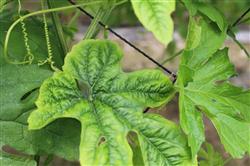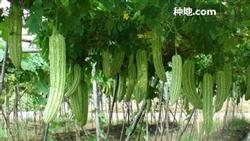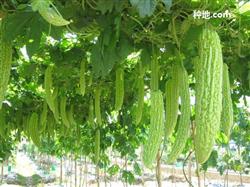How to control diseases and insect pests of balsam pear?

How to control diseases and insect pests of balsam pear? The pests that are difficult to control are melon fruit fly, melon aphid and melon silk borer. 1. Melon fruit fly: commonly known as "needle wasp", adults lay eggs in melons and fruits, and larvae eat in melon flesh, resulting in melon rot and even fruit drop, seriously affecting the quality and yield of melons. At present, it is the peak period for the emergence of needle wasps, and the comprehensive management methods of pastoral cleaning, trapping and killing adults, insecticides and bagging melons are adopted. It is recommended to use kung fu to kill insects with chemicals. A small bag (5 ml) of Kung Fu on the market can be exchanged for a bucket of water (15 liters). Spraying is carried out before 10-11:00 in the morning or 4-6 in the afternoon during the peak period of adult activity, and the effect is better during the adult mating and spawning period. One of the ways to trap and kill is to use yellow board, yellow cardboard or glue board coated with Vaseline in the vegetable garden, about 20 yuan per mu, which has a better trapping and killing effect on adults. Vigorously popularizing the new technology of bagging and protecting melons can not only reduce the damage of various diseases and insect pests, but also improve the quality and commodity value of melons and fruits. 2. Melon aphid: the adults and nymphs of melon aphids are clustered on the back of leaves, tender stems and shoots to absorb juice. The insect will damage the shoot, the leaf curls, the growing point dies, the leaf shrinks, yellowing and shedding ahead of time, it can also cause soot disease and spread virus disease. Pesticide control recommends 25% Aktai water dispersible granule with high efficiency, broad spectrum, safety and lasting for 21 days, which can effectively control melon aphid and many other pests such as thrips and Liriomyza huidobrensis by using 5000-10000 times. 3. Melon silk borer: the larvae gnaw on the leaves, resulting in perforation or engraving of the leaves, which are often eaten into the melon, affecting the yield and quality. Use 50% curon 1000 times or 2.5% kungfu 1500 times spray every 7-10 days. Click to get more balsam pear planting techniques click to get more vegetable planting techniques
- Prev

How can you improve the fertilizer absorption rate of bitter gourd?
How to manage balsam pear can be fruitful? Please guide seed soaking and sprouting to select early and middle mature large balsam pear varieties with exuberant growth, strong fruiting power, full waist and fruit length of more than 25 cm. Seed dressing with new high fat film (which can be mixed with seed coating agent or pesticide) can ward off underground diseases and insects, isolate virus pollution and strengthen seed respiration.
- Next

What do you need to pay attention to in cultivating balsam pear?
What do you need to pay attention to in cultivating balsam pear? Please advise balsam pear is a short-day plant, like temperature, light, heat tolerance, moisture tolerance, not shade tolerance, light length requirements are not strict, longer light is conducive to its good growth, higher requirements for soil moisture and air humidity, but not resistant to waterlogging; wide adaptability, can be in the south of our country.
Related
- Where is it suitable to grow horseradish in China? it is expected to see the middle altitude horseradish in Alishan.
- How to prevent tomato virus disease reasonably? (Control methods included)
- Many people like to plant towel gourd on the balcony. What are the main points of this method and management?
- What crops can chili peppers be mixed with?
- Fertilization techniques and matters needing attention in Tomato
- What are the grafting techniques for peach seedlings in spring?
- Harm and control methods of root swelling disease of Chinese cabbage
- What are the pests of sweet potatoes? How to prevent and cure it?
- Symptoms, causes and Control methods of navel Rot in Tomato
- The cause of "Cucumber rotten bibcock" in Farmers' planting Cucumber and its Control Plan

